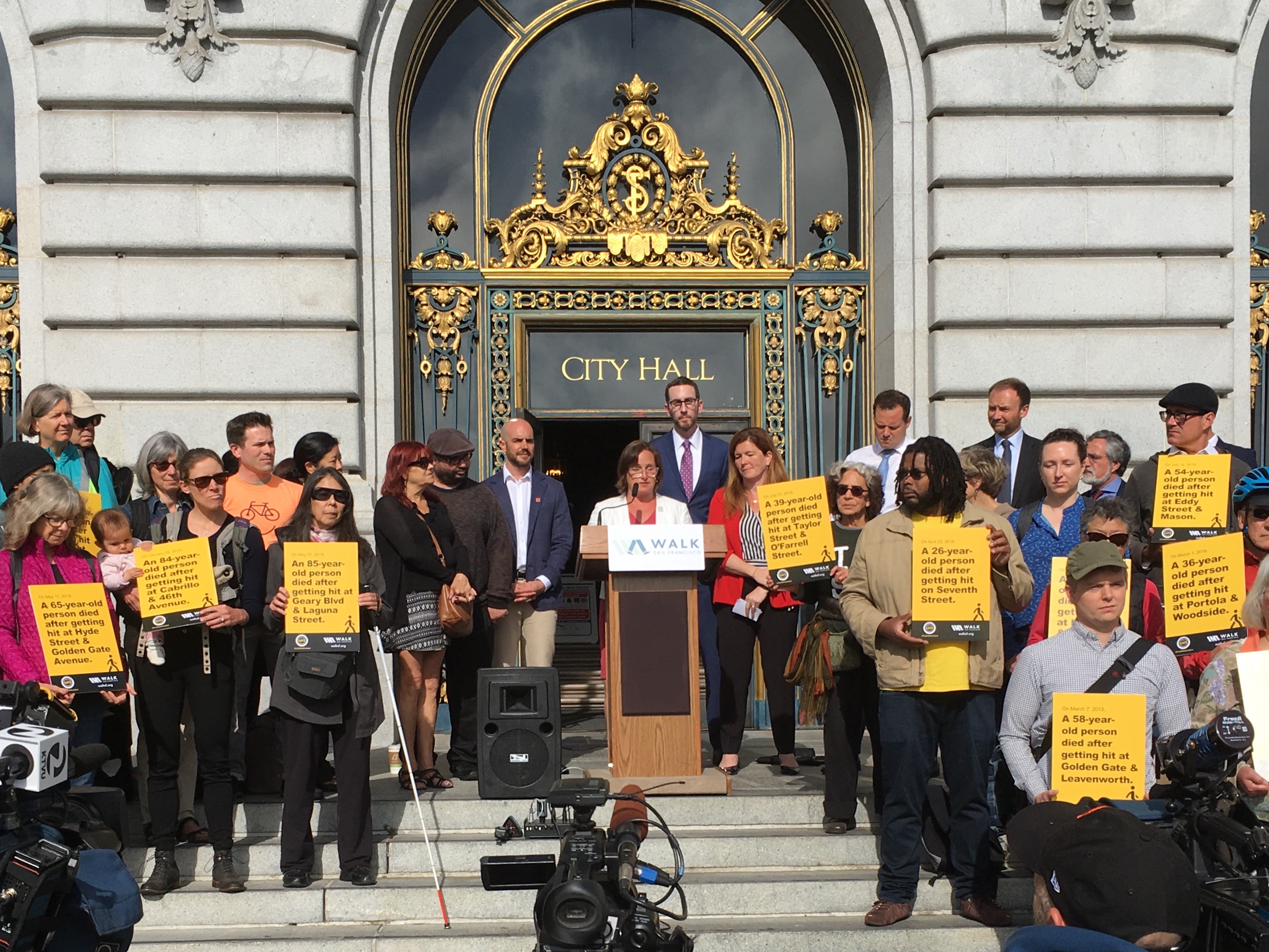Note: Metropolitan Shuttle, a leader in bus shuttle rentals, regularly sponsors coverage on Streetsblog San Francisco and Streetsblog Los Angeles. Unless noted in the story, Metropolitan Shuttle is not consulted for the content or editorial direction of the sponsored content.
In response to a death last week and another over the weekend on the notoriously dangerous streets of the Tenderloin, Walk San Francisco held a rally Tuesday morning to demand that the city take emergency measures to provide safe streets.
"We’re here today because fourteen people have died while walking and biking in our city already this year. Fourteen people!" said Walk San Francisco's Jodie Medeiros, in an address to the crowd and media at the steps of San Francisco City Hall. "And we lost two of those people in just the past five days, in horrific crashes."
“The city needs to declare a state of emergency for traffic safety,” she added in a prepared statement.
Last Thursday, Michael Evans was hit while walking at Mason and Eddy and dragged for blocks by a commercial big rig. He died that day. On Sunday, at Taylor Street and O’Farrell, Benjamin Dean was killed by the driver of a Tesla. His wife, Kelly Dean, was critically injured.
“This is a crisis. People are dying on our streets. We need proactive and immediate traffic safety changes throughout the Tenderloin to save lives now,” said Supervisor Matt Haney, who represents the district, also in a prepared statement. “These are neighborhood streets. We aren’t a freeway. Our streets should be two-way, with narrow lanes, leading pedestrian intervals, pedestrian scrambles, and red light cameras to keep speeds low and people safe.”
Other speakers at the rally included State Senator Scott Wiener, Interim SFMTA Director Tom Maguire, and Brian Wiedenmeier, Executive Director of the SF Bicycle Coalition.
Sup. @MattHaneySF calls the traffic violence we’re seeing as “senseless” and echoes Walk SF’s ask for declaring a “state of emergency” for traffic crashes.
— SF Bicycle Coalition (@sfbike) July 23, 2019
“While progress is being made, it’s not enough ... we need to slow our streets and design them for people, not cars.” pic.twitter.com/irrLc9tjJo
“I’m tired of standing up here. What we need is change," said Wiedenmeier.
Advocates are demanding that the city immediately begin:
- Applying the same prosecutorial scrutiny to deaths from traffic violations that it does to other deaths by violent means.
- Increased enforcement by the San Francisco Police Department to reach its target of issuing fifty percent of traffic citations to the five most common causes of collisions and injuries. (SFPD are not yet meeting this goal; in FY 2017-2018 the citations reached 44 percent.)
- Bringing speed safety cameras to San Francisco. (For comparison, New York City will have 750 speed cameras installed at school zones by this time next year.)
- Lowering speed limits on all San Francisco streets. We think that "20 is plenty" on all residential streets, which would include most streets in the Tenderloin. The speed limits on commercial streets should also be revisited, considering many are designated as high-injury corridors and have very high numbers of people walking and biking on them.
- Analyzing all severe and fatal traffic crashes in the past five years to identify root causes and recommendations for preventative actions.
- Installing additional red light cameras at many more major high-injury intersections.
- Designing all safety projects on the high-injury network to reach the highest possible standards, prioritizing people over vehicles.
After a reduction in traffic fatalities and serious injuries in 2017, to 20 deaths, the macabre count has crept steadily back up. In 2018 there were 23 fatalities. 2019's 14 fatalities--with five months to go--is on track to beat those numbers.
"Our city can and must do a lot better, starting right now, to protect all of us," said Medeiros.





